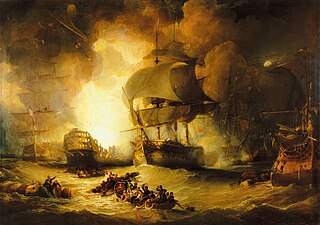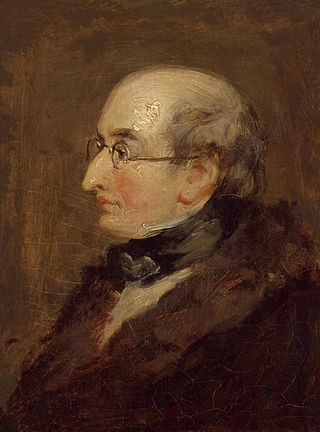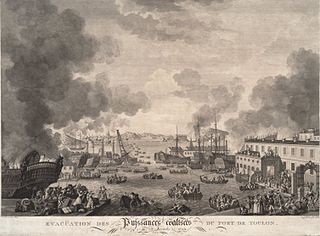
The Battle of the Nile was a major naval battle fought between the British Royal Navy and the Navy of the French Republic at Aboukir Bay on the Mediterranean coast off the Nile Delta of Egypt from the 1st to the 3rd of August 1798. The battle was the climax of a naval campaign that had raged across the Mediterranean during the previous three months, as a large French convoy sailed from Toulon to Alexandria carrying an expeditionary force under General Napoleon Bonaparte. The British fleet was led in the battle by Rear-Admiral Sir Horatio Nelson; they decisively defeated the French under Vice-Admiral François-Paul Brueys d'Aigalliers.

Plymouth Sound, or locally just The Sound, is a deep inlet or sound in the English Channel near Plymouth in England.

Joseph-Napoléon Bonaparte was a French statesman, lawyer, diplomat and older brother of Napoleon Bonaparte. During the Napoleonic Wars, the latter made him King of Naples (1806–1808), and then King of Spain (1808–1813). After the fall of Napoleon, Joseph styled himself Comte de Survilliers and emigrated to the United States, where he settled near Bordentown, New Jersey, on an estate overlooking the Delaware River not far from Philadelphia.

Louis Lucien Bonaparte was a French philologist. The third son of Napoleon's second surviving brother, Lucien Bonaparte, he spent much of his life outside France for political reasons. After a brief political career, he focused on his academic work, which particularly centered on the Basque language and the Celtic languages.

Napoleon Bonaparte, later known by his regnal name Napoleon I, was a French emperor and military commander who rose to prominence during the French Revolution and led successful campaigns during the Revolutionary Wars. He was the leader of the French Republic as First Consul from 1799 to 1804, then of the French Empire as Emperor of the French from 1804 until 1814, and briefly again in 1815. His political and cultural legacy endures as a celebrated and controversial leader. He initiated many enduring reforms, but has been criticized for his authoritarian rule. He is considered one of the greatest military commanders in history and his wars and campaigns are still studied at military schools worldwide. However, historians still debate the degree to which he was responsible for the Napoleonic Wars, in which between three and six million people died.

Benjamin Robert Haydon was a British painter who specialised in grand historical pictures, although he also painted a few contemporary subjects and portraits. His commercial success was damaged by his often tactless dealings with patrons, and by the enormous scale on which he preferred to work. He was troubled by financial problems throughout his life, which led to several periods of imprisonment for debt. He died by suicide in 1846.

HMS Bellerophon, known to sailors as the "Billy Ruffian", was a ship of the line of the Royal Navy. A third-rate of 74 guns, she was launched in 1786. Bellerophon served during the French Revolutionary and Napoleonic Wars, mostly on blockades or convoy escort duties. She fought in three fleet actions: the Glorious First of June (1794), the Battle of the Nile (1798) and the Battle of Trafalgar (1805). While the ship was on blockade duty in 1815, Napoleon boarded Bellerophon so he could surrender to the ship's captain, ending 22 years of almost continuous war between Britain and France.

Île-d'Aix is a commune in the French department of Charente-Maritime, region of New Aquitaine, off the west coast of France. It occupies the territory of the small Isle of Aix, in the Atlantic Ocean. It is a popular place for tourist day-trips during the summer months.

Charles Tristan, Marquis de Montholon was a French general during the Napoleonic Wars. He chose to go into exile on Saint Helena with the ex-emperor after Napoleon's second abdication.

Sir Charles Lock Eastlake was a British painter, gallery director, collector and writer of the 19th century. After a period as keeper, he was the first director of the National Gallery. From 1850 to 1865 he served as President of the Royal Academy, succeeding Martin Archer Shee in the role.

The siege of Toulon was a military engagement that took place during the Federalist revolts and the War of the First Coalition, part of the French Revolutionary Wars. It was undertaken by forces of the French Republic against Royalist rebels supported by Anglo-Spanish forces in the southern French city of Toulon. It was during this siege that young Napoleon Bonaparte first won fame and promotion when his plan, involving the capture of fortifications above the harbour, was credited with forcing the city to capitulate and the Anglo-Spanish fleet to withdraw. The siege marked the first involvement of the British Royal Navy with the French Revolution.

The French campaign in Egypt and Syria (1798–1801) was a Napoleonic campaign in the Ottoman territories of Egypt and Syria, executed by Napoleon Bonaparte. Napoleon proclaimed to "defend French trade interests" and to establish "scientific enterprise" in the region. It was the primary purpose of the Mediterranean campaign of 1798, which was a series of naval engagements that included the capture of Malta and the Greek island Crete, later arriving in the Port of Alexandria. The campaign ended in defeat for Napoleon after abandoning his troops to head back to France for the looming risk of a Second Coalition. This led to the death and withdrawal of French troops in the region.

Orient was an Océan-class 118-gun ship of the line of the French Navy, famous for her role as flagship of the French fleet at the Battle of the Nile in August 1798, and for her spectacular destruction that day when her magazine exploded. The event was commemorated by numerous poems and paintings.

Events from the year 1815 in the United Kingdom. 1815 marks the end of years of war between the United Kingdom and France when the Duke of Wellington wins a decisive victory over Napoleon at the Battle of Waterloo. Fighting in the War of 1812 between the UK and the United States also ceases, peace terms having been agreed at the end of 1814. The year also sees the introduction of the Corn Laws which protect British land owners from cheaper foreign imports of corn.

HMS Northumberland was a 74-gun third-rate ship of the line of the Royal Navy, built at the yards of Barnard, Deptford and launched on 2 February 1798. She carried Napoleon to his final exile on St Helena.

Bonaparte Crossing the Alps is a 1848–1850 oil painting by French artist Paul Delaroche. The painting depicts Napoleon Bonaparte leading his army through the Alps on a mule,[I] a journey Napoleon and his army of soldiers made in the spring of 1800 in an attempt to surprise the Austrian army in Italy. Several versions of this painting exist: in the Louvre- Lens and the Walker Art Gallery in Liverpool, England. Queen Victoria owned a small version of it.

Rear-Admiral Sir Frederick Lewis Maitland was an officer in the Royal Navy during the French Revolutionary and Napoleonic Wars. He rose to the rank of rear admiral and held a number of commands. The most famous event of his career occurred when Napoleon Bonaparte surrendered to him aboard HMS Bellerophon, marking the final end of the Napoleonic Wars.

Bonaparte Visits the Plague Stricken in Jaffa is an oil-on-canvas painting commissioned by Napoleon Bonaparte and painted in 1804 by Antoine-Jean Gros, portraying an event during the French invasion of Egypt. The scene shows Napoleon during a striking scene which is supposed to have occurred in Jaffa on 11 March 1799, depicting the French general making a visit to his ill soldiers at the Armenian Saint Nicholas Monastery.
Vice Admiral Charles Bayne Hodgson Ross was a Royal Navy officer who served during the French Revolutionary and Napoleonic Wars, who later commanded the ship that took Napoleon Bonaparte into his finale exile on St Helena, and who went on to be Commander-in-Chief, Pacific Station.

War. The Exile and the Rock Limpet is an oil painting of 1842 by the English Romantic painter J. M. W. Turner (1775–1851). Intended to be a companion piece to Turner's Peace - Burial at Sea, War is a painting that depicts a moment from Napoleon Bonaparte's exile at Saint Helena. In December 1815, the former Emperor was taken by the British government to the Longwood House, despite its state of disrepair, to live in captivity; during his final years of isolation, Napoleon had fallen into despair. Turner's decision to pair the painting with Peace was heavily criticized when it was first exhibited but it is also seen as predecessor to his more famous piece Rain, Steam and Speed – The Great Western Railway (1844).



















